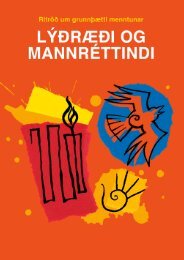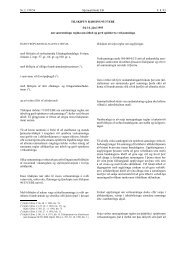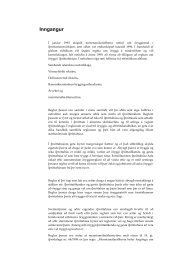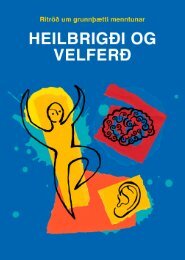Arts and Cultural Education in Iceland : Professor Anne Bamford
Arts and Cultural Education in Iceland : Professor Anne Bamford
Arts and Cultural Education in Iceland : Professor Anne Bamford
Create successful ePaper yourself
Turn your PDF publications into a flip-book with our unique Google optimized e-Paper software.
dem<strong>and</strong><strong>in</strong>g more of our schools <strong>and</strong> teachers The idea of 40 m<strong>in</strong>ute lessons ru<strong>in</strong>s<br />
education. The arts become restricted to week by week lessons that are not connected to anyth<strong>in</strong>g else. The<br />
barriers are strong <strong>and</strong> high. It won’t be easy to get these barriers down (either <strong>in</strong> schools or <strong>in</strong> cultural<br />
<strong>in</strong>stitutions). Yet we have to change schools. We are enter<strong>in</strong>g a creative age. We need to change schools – 40<br />
m<strong>in</strong>utes is a state of m<strong>in</strong>d not a rule. The schools are so focused on timetables <strong>and</strong> regulations. We need reeducation.<br />
What is my child supposed to know?<br />
Many <strong>in</strong>terviewees po<strong>in</strong>ted to a number of structural elements such as curriculum <strong>and</strong><br />
timetabl<strong>in</strong>g that actually prevent <strong>in</strong>tegration. Competition between the arts discipl<strong>in</strong>es was also<br />
identified as be<strong>in</strong>g a problem that reduced the likelihood that there would be greater <strong>in</strong>tegration<br />
of the arts:<br />
We (textile) want to connect more to visual arts but there is always some competition there. We are both<br />
electives <strong>and</strong> the clever students want to take visual arts, but we can see that they would also be very good at<br />
design. There is a false assumption that textile is easier, but to be good at design takes a lot of work <strong>and</strong> very<br />
creative <strong>and</strong> <strong>in</strong>novative ways of th<strong>in</strong>k<strong>in</strong>g.<br />
We need a new vision for the compulsory school. Subjects are still isolated. The curriculum is still subject<br />
orientated.<br />
The curriculum is too square. We need more flow between subjects. We need to activate the pupils more. In all<br />
subjects, we need to put <strong>in</strong> creativity.<br />
Integration? We've talked about it, <strong>and</strong> the philosophy, but not done much... I will do it <strong>in</strong> the future, also more<br />
art history mixed with regular history.<br />
There is little or no <strong>in</strong>tegration of subjects. The reason is probably the subject-oriented curricula.<br />
A lack of <strong>in</strong>tegration was seen as a factor that limited the “full” benefit of the arts be<strong>in</strong>g felt<br />
more broadly (especially <strong>in</strong> the economy).<br />
Isolation between subjects means that we do not get the full benefit of the arts. We need to use arts more <strong>in</strong> all<br />
subjects. Learn<strong>in</strong>g how to <strong>in</strong>tegrate is a major shortcom<strong>in</strong>g <strong>in</strong> our education system.<br />
Figures 4.1.1 to 4.1.6 show the differences <strong>in</strong> subject distribution over different grade levels <strong>and</strong><br />
the reduced presence of <strong>in</strong>tegrated learn<strong>in</strong>g by comparison.<br />
Figure 4.1.1 Art subjects are compulsory <strong>in</strong> grades 1 – 4<br />
Figure 4.1.2 Art subjects are compulsory <strong>in</strong> grades 5 - 7<br />
89


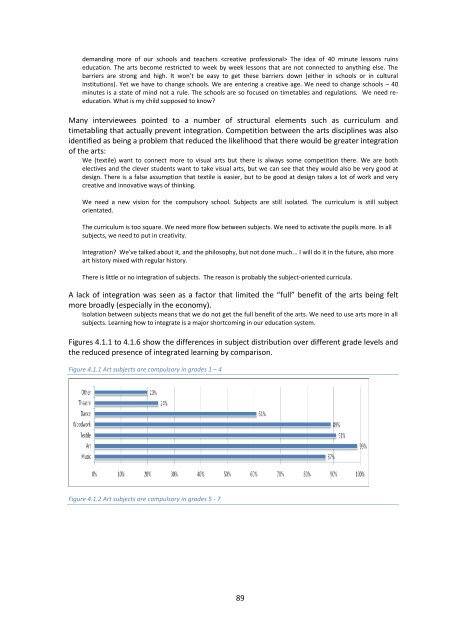
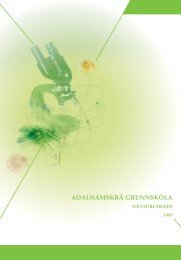
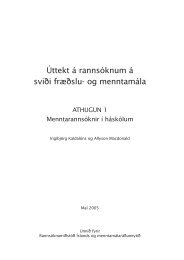

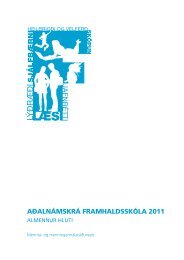
![Aðalnámskrá tónlistarskóla : rytmÃsk tónlist [Eingöngu á rafrænu formi]](https://img.yumpu.com/50843672/1/184x260/aaalnamskra-tanlistarskala-rytma-sk-tanlist-eingangu-a-rafranu-formi.jpg?quality=85)
